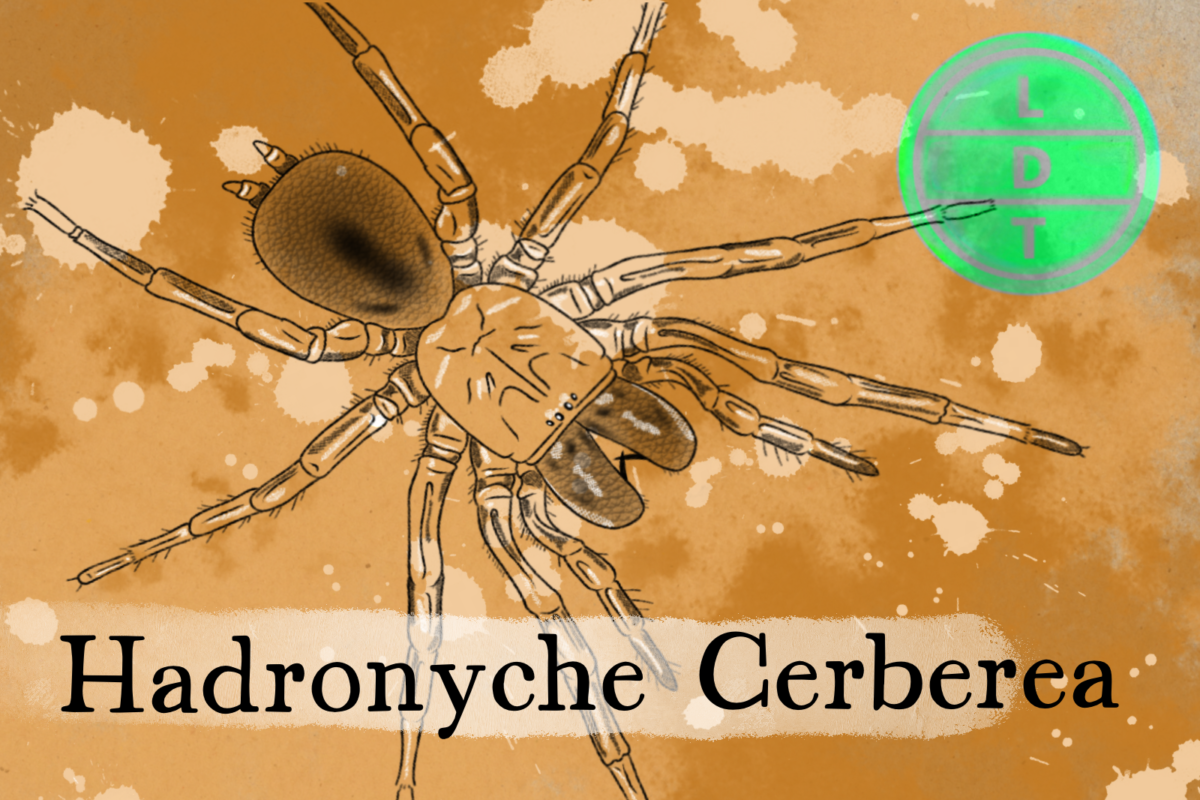“…and today we’re talking about a baleful beast that lives in a silken lair. But more on that later.”
When it comes to venom, every drop counts. No one knows this better than the funnel web spider, one of the world’s deadliest eight-legged freaks. This is definitely one arachnid you don’t want to annoy, since the angrier they are, the more venom they’ll send your way. But why not just give the full dose out with every bite? Well, it’s all part of conserving your lethal resources here in Life, Death, and Taxonomy.
Description of the Funnel-Web Spider
- Body: Funnel-web spiders typically have robust bodies, similar in shape to a tarantula.
- Color: Colors can vary, but they often exhibit earthy tones like brown or gray.
- Legs: They have long and agile legs, each equipped with setae and spines for sensory purposes.
- Eyes: Most funnel web spider species have eight small eyes arranged in two rows.
- Spinnerets: Like other spiders, they possess spinnerets that produce silk for web construction.
Measure Up
Welcome to the beloved Measure Up segment. The official listener’s favorite part of the show! The part of the show when we present the animal’s size and dimension in relatable terms through a quiz that’s fun for the whole family. It’s also the part of the show that’s introduced by you when you send in audio of yourself saying, singing, or chittering the words Measure Up into ldtaxonomy at gmail dot com. We do have a new Measure Up intro!
Aragog from Harry Potter (0:37)
Length
- 1 to 5 cm (0.4 to 2 in)
- How many funnel web spiders go into the height of the tallest point on the Sydney Opera house?
- Hint: The Sydney Opera House was first opened by Queen Elizabeth II in 1973. It is currently home to Opera Australia, The Australian Ballet, and the Sydney Theater Company.
- 1,340 spiders. The Sydney Opera House is 67 meters (219.8 feet) tall.
Lifespan
- 20 years
- How many funnel web spider lifespans go into the age of the city of Damascus?
- Hint: Damascus is famously the city Paul was traveling to when he had an encounter with Jesus post resurrection and ascension, in which he was confronted for persecuting Christians and temporarily blinded. Damascus is in modern day Syria.
- 251.2 lifespans. Damascus was founded around 3,000 BC (Making it around 5,024 years old) but it was inhabited long before that.
Fast Facts about the Funnel-Web Spider
Habitat:
- Funnel web spiders are native to eastern Australia.
- They prefer a range of environments, including grasslands, forests, and gardens.
- While many funnel-web spiders build webs close to the ground, our tree dwelling friend likes to live in trees or higher vegetation.
Funnel-Webs
Funnel-web spiders, including species like the Sydney funnel-web spider, construct silk retreats commonly known as “funnels.” These are tubular or sheet-like structures that serve as the spider’s shelter and hunting ground. The funnel is typically positioned in a protected location, such as under rocks, in leaf litter, or in burrows.
The funnel web spider’s retreat consists of a silk-lined tunnel leading to a wider, flat area, resembling a funnel. The spider waits at the narrow end of the funnel, usually hidden from view, and monitors vibrations in the silk threads with its sensitive legs. When prey, like insects or other small creatures, ventures near the web, the spider quickly emerges to capture and subdue it.
The funnel not only acts as a shelter but also plays a crucial role in ambushing prey. The structure allows the spider to detect and respond rapidly to potential meals, making it an effective tool for hunting in its environment.
Major Fact: Mood Stings
- The venom of one of the world’s deadliest spiders, the funnel-web spider, exhibits variations based on context.
- Their venom has claimed a recorded 13 lives, all before anti-venom was developed
- The lethality of funnel-web venom stems from the presence of a neurotoxin known as “delta-hexatoxin.” This particular toxin has the capacity to be fatal to humans by targeting the nervous system, causing a continuous firing of nerves and keeping them in a perpetually activated state.
- Muscles to go into spasm, blood pressure to drop dangerously, coma and organ failure, and ultimately death – sometimes within a few hours.
- During their youth, male funnel-web spiders possess venom primarily effective against insects, their main source of nutrition. However, as these males embark on the quest for a female mate and venture outside their burrows, their venom undergoes a transformation, becoming potent against vertebrates like reptiles and mammals, including humans.
- These predators can include reptiles (such as lizards or geckos), marsupials (such as antechinus and dunnarts), mammals (such as rats) and birds.
- Funnel-web spider venoms have potential applications, including natural pesticides, pharmaceuticals, and antivenom for treating spider bites.
- Research has focused on the molecular complexity of venom but overlooked the spiders’ behavior, physical state, and environment.
- Factors like the spider’s heart rate and defensiveness play a role in determining the proportions of chemicals delivered on the ends of the fangs.
- One species, the Border Ranges funnel-web, showed an association between higher heart rate, defensiveness, and varying venom composition.
- The study suggests species-specific associations between venom composition and physical factors.
- Funnel-web spiders may make behavioral trade-offs, such as adjusting bites and venom quantity, to compensate for the metabolic costs of venom production.
- Understanding these associations could aid in antivenom production and the study of bioactive components in funnel-web venoms.
Ending: So head out from your burrow, keep an eye out for lizards, and hand out whatever toxins you feel like like the funnel-web spider here in LDT

